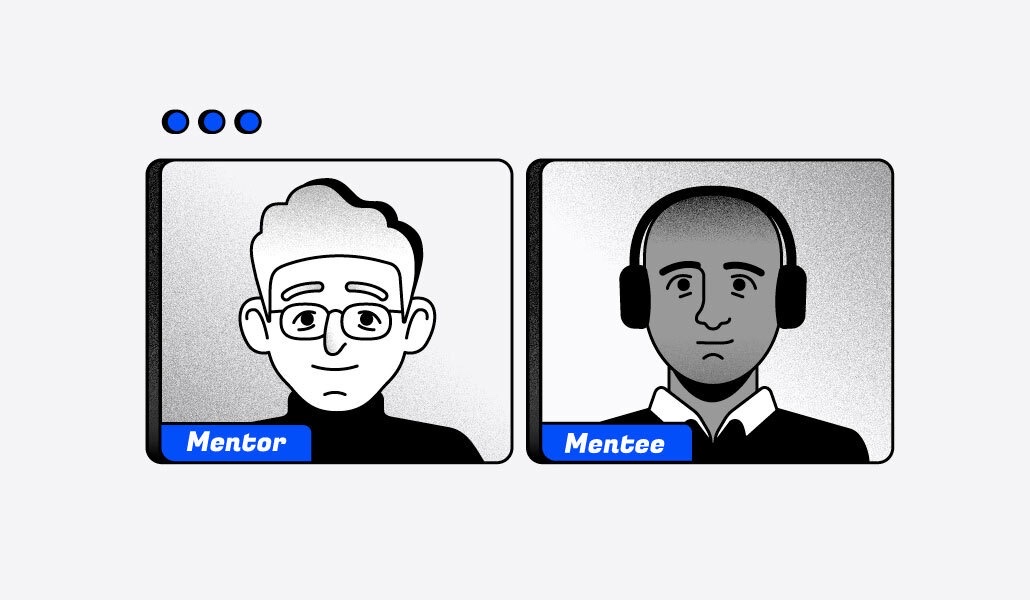Why reverse mentoring could be the key to engaging – and retaining – younger employees

We’re all aware of the tradition of mentoring in the workplace, where more experienced employees guide younger generations of professionals. But what about reverse mentoring?
According to Deloitte, Gen Z and millennials account for nearly half of the full-time workforce in the U.S., and a growing number of companies see younger generations of employees as possessing skills and perspectives that are invaluable to the organization. While older employees are able to share insight into their work ethics, corporate know-how and general fundamentals, Gen Z and millennial employees, they believe, can provide expertise in areas such as the latest technology, the hottest social media platforms and other cultural and workplace trends.
It is a trend that’s seeing momentum, having been championed by companies like Land O’ Lakes, which this month kicked off the second round of its Reverse Mentorship Program. Open to everyone in the company, the nine-month initiative “focuses on the understanding that intergenerational discussions are key in both newer-in-their-career employees and more senior employees,” the company said on its blog.
And reverse mentorship could be a remedy to the Great Resignation and companies holding on to disaffected younger generations of workers. “Younger employees generally do not see themselves as beholden to a single employer,” explained David McConaghy, a psychiatrist in Portland, Oregon. “Rather than that, what drives them is the value placed on their effort, which renders reverse mentoring an excellent match for them. Nothing conveys the message ‘We respect your abilities and commitment to the firm’ quite like encouraging someone to share their knowledge, mentor and motivate others.”
Additionally, McConaghy argued, reverse mentoring helps establish ties among the workforce and connects workers to an organization and its ideals. “And for millennials and Generation Z,” he said, “this feeling of closeness and value congruence is critical to their satisfaction.”
Younger employees’ own experiences would seem to bear that out. “I have tried to be a mentor and leader for younger people in the past but have never had an opportunity to be a mentor for someone older than I am. I was appreciative of the fact that Land O’ Lakes recognizes talent and leaders within the younger generations and is attempting to learn how to be communicate with, and retain, that talent,” as Kristi Sollman, a senior sales manager at Land O’ Lakes, related. “I was also excited for the opportunity to have an open and safe dialogue with senior leaders within Land O’ Lakes and hear about their professional journeys on how they got to where they are now.”
Many believe showing younger workers that learning and understanding new things is not a one-way street, is critical for any workplace. “Any time someone asks me to mentor them, I tell them it is a two-way street, and we discuss their expertise, their hobbies and skills,” said Sharon Ray, head of diversity, equity and inclusion at Envoy Global, an immigration management firm based in Chicago. “Then we agree on a topic or skill that each of us will provide at our next meeting. It’s so important to make sure everyone feels they can contribute their knowledge. I really enjoy learning from others and seeing their faces light up when they realize they have expertise that can be shared.”
Ray said she started thinking about reverse mentoring when she was given her first mentor, early in her career at a large corporation. She related that she was assigned the mentor with no context of what it was supposed to be like other than learning ways to work successfully in the company. “What it was missing for me is the two-way conversation and how I could give my mentor feedback that I thought would be helpful as we were building our mentoring relationship,” she said. “Of course, this did not go over well. I did have some expertise although, not specifically in business operations. I always took this with me as I went to other jobs/roles within the company. Once I moved into the entrepreneurial world, reverse mentorship was widely received as a tool that was engaging and helpful.”
When it comes to companies establishing a reverse mentoring program, Ray advised first making sure the definition of mentorship is understood across the organization and that the rules of the road are clearly defined. For example, an employer should determine whether mentors choose a mentee or if someone in the organization will be matching colleagues based on specific criteria. Each mentor and mentee should be considered for their skills, interests and hobbies so that in the matching process, colleagues can be better aligned, she encouraged her fellow leaders.
Reverse mentorship is also beneficial in that it allows for the advancement of DE&I initiatives, stressed Joe Manna, content manager at Alyce, a Boston-based corporate gifting firm. “By allowing various generations to connect and share ideas and talents, reverse mentoring promotes diversity and inclusion,” he said. It also builds professional sensitivity and understanding, he added. “For instance, businesses may pair younger LGBTQ professionals, individuals of color or employees with impairments with managers to assist leaders in comprehending their experiences and ideas.”
Meanwhile, Dan Rasmus, an author and business consultant based in the Seattle area, prefers another term for give and take among generations of employees — reciprocal mentoring. “Reverse sounds like the flow changes direction,” he said, adding, “Those evergreen and legacy skills have value, and cooperative learning is more effective than lecturing. This should be bi-directional, where those teaching older workers emergent skills remain open, and perhaps even compelled, to learn about the business, the market, and technology, that may not be of first-order use to them, but remains essential to performing in a role. The shared openness to learning keeps the dialog moving, and the absorption of knowledge higher.”
3 Questions with Anna Dearmon Kornick, certified time management coach and head of community for time management platform Clockwise
Why is the current five-day work week structure we currently have unsustainable?
It’s not that the five-day work week structure itself is unsustainable, it’s the culture within some companies that is unsustainable. When a five-day work week blends into evenings and weekends, and the expectations around workload and availability are unrealistic, employees can feel overwhelmed and burned out. Evenings and weekends don’t provide necessary and proper recharge in companies with this type of culture because employees feel the need to always be “on” and use downtime to play catchup.
It’s not a time problem. It’s a culture problem.
Parkinson’s Law states that work expands to fill the time allotted. When there are clear expectations for deadlines, boundaries in place for communication during off hours, and reasonable workloads in place, a five day work week becomes much more sustainable.
How should employers address this, by providing alternatives like the 4-day week? If so, why, and if not, why?
In theory, a four-day work week sounds like the answer to a lot of our burnout problems. When employees have a third day available to recharge, it would seem that they’d be able to return to work feeling refreshed. However, simply slashing one working day from the week isn’t enough to reduce burnout and recharge our teams. The first step is to make sure that your company’s culture truly supports healthy boundaries and realistic expectations. Do you have the right systems, rhythms and policies in place to support a four day week? If not, that extra day off will turn into another day to catch up on work — defeating the purpose of the four-day work week altogether.
If the 4 day week isn’t sustainable, then what is the alternative?
While a four-day week in a healthy company culture can absolutely be sustainable, it may not be sustainable for every role in every organization. Entire teams in crisis communication, customer service and support roles, for example, may not be able to adequately support their customers in only four days per week. This is where we may see rotating schedules or “on call” schedules become necessary for teams that adopt a four-day week.
I believe we’ll continue to see organizations test-driving new approaches to structuring work hours and employee availability. Companies that successfully transition to a four-day week by making the necessary adjustments to their company culture will become highly attractive for top talent. A sustainable work culture looks different for each company, but when leaders approach this decision as a culture problem, not just a time problem, they will find unique ways to support their employees’ mental health and happiness. — Jessica Davies.
By the numbers
- 83% of 11,000 people polled across 15 countries, said they are more likely to work for organizations that take action and are able to clearly demonstrate the progress they are making on environmental and social issues
[Source of data: Oracle report.] - 68% of 1,000 U.S. workers polled said they would switch employers for one with greater pay transparency — even if their job responsibilities and salary remained the same.
[Source of data: Visier report.] - 4 in 10 people (out of 4,000 polled) who quit their jobs during the pandemic now admit they were actually better off at their old job.
[Source of data: UKG report.]
What else we’ve covered
- Companies need to be aware of how criminals are using virtual meeting platforms to scam unsuspecting employees and eavesdrop on sensitive commercial information.
- People are starting to swap their traditional ‘out of the office’ automatic email replies for ‘in the office’ in an attempt to deter people from sitting on video calls while in the office.
- Some individuals say their partner’s remote work habits impacted their relationship so much that they’ve even considered a breakup or divorce.
- There are some pandemic habits professionals don’t want to lose: the walking meeting. That’s why many of them have continued the ritual now they’re back in the office.
- A high percentage of managers recently surveyed said severe consequences would occur – including pay cuts, loss of benefits, even termination – for those who refuse to return to the office.
- The term “hoteling” can sometimes be used interchangeably with “hot desking” — which makes the whole thing even more confusing. We break out the differences.
- So far in 2022, more than 4 million people have resigned each month either to seek new jobs or changing careers entirely. Here is what’s driving it.
- Pandemic pet owners are now scrambling with how to keep their dogs with them when they return to the office. But many find having pets at work with them more stressful than not.
- Offices are getting a facelift to facilitate in-person work that has multiple zones for the type of task being done.
What we’re reading
- JP Morgan is monitoring its employees’ office attendance rates by tracking when they swipe their IDs, a tactic that’s causing fear and panic among staff (Insider).
- Around a dozen companies are paring down the number of days employees spend in the office from three to two [WSJ].
- Senior execs are pushing staff to return to the office, but only a fraction of these execs are following that themselves — many preferring to stay remote [Bloomberg].

